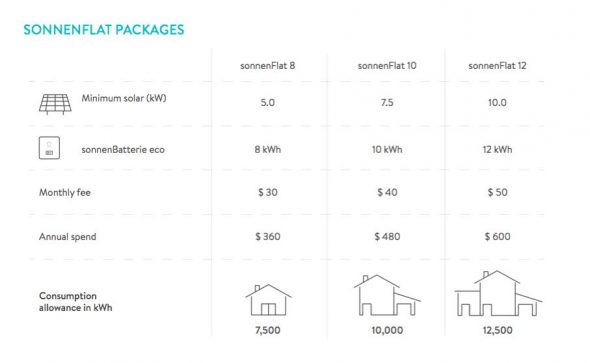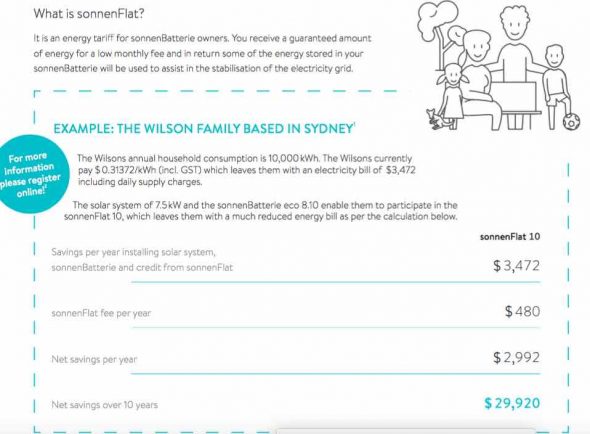
Christoph Ostermann, the founder and CEO of German battery storage developer Sonnenbatterie, could hardly believe his luck: Just as he prepared to announce a plan to take Australia’s energy utilities “out of business”, the utilities announced – en masse – a near 20 per cent jump in the cost of grid power.
The Australia battery storage market – already seen by Sonnen as the one of the most promising in the world thanks to its excellent sunshine, its high penetration of rooftop solar, volatile energy markets and extremely high retail electricity prices – suddenly got even more attractive.
“It was perfect. We said: ‘Thankyou very much’,” Ostermann told journalists at the launch of the Sonnenflat battery storage retail product in Sydney on Wednesday night.
Sonnen unveiled what it describes as a major assault on the traditional energy utility business model by introducing a unique offer that replicates the sort of deal consumers can get from a mobile phone company, and with a quick pay-back.
“That’s our goal, to take the traditional utility out of business,” Ostermann says. “What we do is provide grid power for free.”

Well, not quite, but almost. A household with at least 5kW of solar can buy one of Sonnen’s battery storage systems, and then be provided with all their electricity needs for a flat rate of $30, $40, or $50 a month, depending on the size of their solar system, storage and daily usage.
This graph above illustrates what is available. An average house will be able to consume around 10,000kWh a year, or nearly 30kWh a day, and cut its annual bill of around $3,400 to just $480 a year.
Of course, you also need the battery storage, which might cost around $15,000 for an average system. But even this would provide a pay-back within 5 years, and so once paid off the only cost to the consumer is the annual fee. Sonnen provides a guarantee for its storage systems of 10,000 cycles. That effectively gives it a near 20 year life.

The Sonnenflat product is designed to take the hassle and confusion out of the solar and storage equation, which can be devilishly complicated for the consumer.
It merges, into one product, the various new concepts such as peer-to-peer trading and virtual power plants. The participants in the Sonnenflat will essentially sell excess power to each other, or to Sonnen, who then package it up and use it to trade – via a third party – in the wholesale and other markets, such as ancilliary services.
For the customer, it takes away the pressure and worry about when to use appliances. They don’t have to care about load shifting or how much is stored or exported or drawn down from the grid.
For a flat fee, Sonnen will take care of it, the customer users what they want, within certain parameters. (And, it should be pointed out, it may not be available in areas with very high fixed network charges, such as in Essential Energy)
Sonnen says it already has around 600-700 battery storage installations across Australia since it entered the market last November, and by the end of this year it aims to have 2,000 customers taking part in its Sonnenflat system. That equates to a “virtual power plant” of around 20MWh.
But in 2018, it expects to increase that number four-fold (80MWh) and then to double it each year.
Ostermann says the market is ripe for the picking, particularly the existing fleet of rooftop solar. If one quarter of the 1.6 million households signed up for his deal, then that would equate to a virtual power plant of 1.4GW – nearly the size of the Hazelwood power generator that closed down earlier this year.
He sees the retrofit market as the most promising, because many households have effectively paid off their solar system. But the falling cost of solar panels also makes it attractive for new customers.
Professor Ross Garnaut, the chairman of Zen Energy, the Adelaide-based battery storage developer which has a partnership with Sonnen, described it as an “important step in Australia’s energy transition.”
Would this kill the traditional energy utility business model, I asked him during the presentation. “That’s the idea,” he said.
Indeed, Ostermann says that utilities that do not evolve will die. But Sonnen is seeking alliances among the incumbents as well. Before the launch, it was holding discussions with AGL Energy about using its wholesale market trading systems.
It has also signed up a small retailer to manage the customers. It wouldn’t say who it was, but RenewEconomy understands it is the new energy start-up Energy Locals.
Ostermann says that utilities will have no choice but to write down their assets as they understand the implications of all this rooftop solar and battery storage providing “free electricity” once their purchase price has been amortised.
“They are sad and happy at same time. They are laughing and crying. It’s like standing at train station and watching (a train) leave and trying to run and catch up with it when they realise ‘oh shit, our business model is disrupted.’
“They are trying to adapt. They are intelligent enough to recognise that it is impossible with their current model.
“If you look 10 years ahead, you will see amortised PV sites that are generating electricity at zero cost. New installations are getting cheaper and cheaper. They will have to write off assets they sitting on.”
The indications are that battery storage market is showing signs of rapid expansion, according to Jonathon Fisk, co-founder and director of Solaray Energy.
“In June alone, Solaray took orders for over half a megawatt of storage just in Sydney and we see the Sonnenflat product adding to our rapid and continued growth,” he says.
“It will give our customers the option to never pay for energy again. This is the model for the future and could well be how the majority of batteries and solar PV is bought in the future.” Solaray also distributes Tesla and Enphase batteries.
Giles Parkinson is founder and editor of One Step Off The Grid, and also edits and founded Renew Economy and The Driven. He has been a journalist for 35 years and is a former business and deputy editor of the Australian Financial Review.
